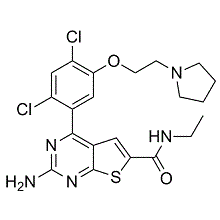| Description: |
VER-82576 (NVP-BEP800) is a potent, orally available and selective Hsp90 inhibitor, with an IC50 of 58 nM for Hsp90β; VER-82576 also slightly blocks Grp94 and Trap-1, with IC50s of 4.1 and 5.5 μM, respectively. |
| Target: |
HSP90β:58 nM (IC50)
GRP94:4.1 μM (IC50)
TRAP-1:5.5 μM (IC50) |
| In Vivo: |
VER-82576 (NVP-BEP800; 15 or 30 mg/kg, p.o.) shows antitumor activities in A375 cancer xenografts and BT-474 xenograft-bearing mice[1]. |
| In Vitro: |
VER-82576 (NVP-BEP800) is a potent and selective Hsp90 inhibitor, with an IC50 of 58 nM for Hsp90β and is >70-fold selective against Grp94 and Trap-1, with IC50s of 4.1 ± 1.1 and 5.5 ± 0.48 μM. VER-82576 potently inhibits the proliferation of tumor cells, with GI50s ranging from 38 nM in A375 cells to 1050 nM in PC3 cells, with an average GI50 of 245 nM. VER-82576 (250-1250 nM) depletes client proteins in human cancer cell lines in vitro[1]. VER-82576 (NVP-BEP800; 200 nM) shows no significant effect on the ionizing radiation (IR) dose-response curves of A549 cells, and is less toxic to SNB19 cells. VER-82576 in combination with IR results in more severe DNA damage in both A549 and SNB19 cell lines than each treatment alone and also protracts the kinetics of DNA damage repair in SNB19 cells[2]. VER-82576 (NVP-BEP800; 0.05, 0.1 or 0.2 μM) dose-dependently decreases the viability and induces apoptosis of glioblastoma cells. VER-82576 (0.2 μM) suppresses the expression of IKKβ protein but does not alter the levels of IKKβ mRNA in T98G cells. VER-82576 (0.2 μM) suppresses the expression of heat shock protein 70[3]. |
| Cell Assay: |
Prior to treatments, the cells are placed into 6-well plates in medium at a density of 1 × 105 cells/well, three wells per treatment group and cultured for 24 h. The cells are divided into treatment groups and treated accordingly for 40 h: vehicle control (DMSO, 0.016%, v/v), VER-82576 (0.05, 0.1 or 0.2 μM), irradiation (10 Gy), or VER-82576 (0.05, 0.1 or 0.2 μM) in combination with irradiation (10 Gy). Upon completion of the treatment, all cells are incubated with 0.5 mg/ml MTT for 3 h. The relative viability of the treated cells to the untreated control cells is measured. The absorbance is measured at 490 nm on a microplate reader[3]. |
| Animal Administration: |
The estrogen receptor (ER)-positive, ErbB2-overexpressing cell line BT-474 is grown in DMEM high glucose (4.5 g/L) supplemented with 10% FCS, 200 mM l-glutamine, and 1% sodium pyruvate (BioConcept). Two or 3 d before cell inoculation, each mouse is s.c. implanted on the upper dorsal side with a 17β-estradiol pellet (25 μg/d; 90-d release) using a trocar needle. BT-474 cells (5 × 106) are injected in 200 μL Matrigel/HBSS (1:1 volume) s.c. in the right flank. The A375 cell line expresses mutant B-Raf (V600E). The cells are grown in RPMI 1640 supplemented with 10% FCS and 200 mM l-glutamine. To establish tumors, 5 × 106 A375 cells are injected s.c. in 200 μL PBS in the right flank. The animals are kept under optimized hygienic conditions with a 12-h dark, 12-h light cycle. The animals are fed food and water ad libitum. Tumor growth and body weights are monitored at regular intervals. The xenograft tumor sizes are measured manually with calipers, and the tumor volume is estimated using the following formula: (W × L × H × π/6), where width (W), length (L), and height (H) are the three largest diameters. Treatment with VER-82576 is initiated when the average tumor volume reaches 100 to 300 mm3[1]. |
| References: |
[1]. Massey AJ, et al. Preclinical antitumor activity of the orally available heat shock protein 90 inhibitor NVP-BEP800. Mol Cancer Ther. 2010 Apr;9(4):906-19.
[2]. Niewidok N, et al. Hsp90 Inhibitors NVP-AUY922 and NVP-BEP800 May Exert a Significant Radiosensitization on Tumor Cells along with a Cell Type-Specific Cytotoxicity. Transl Oncol. 2012 Oct;5(5):356-69. Epub 2012 Oct 1.
[3]. Wu J, et al. Irradiation facilitates the inhibitory effect of the heat shock protein 90 inhibitor NVP-BEP800 on the proliferation of malignant glioblastoma cells through attenuation of the upregulation of heat shock protein 70. Exp Ther Med. 2014 Sep;8(3):893-898. Epub 2014 Jun 23. |






















